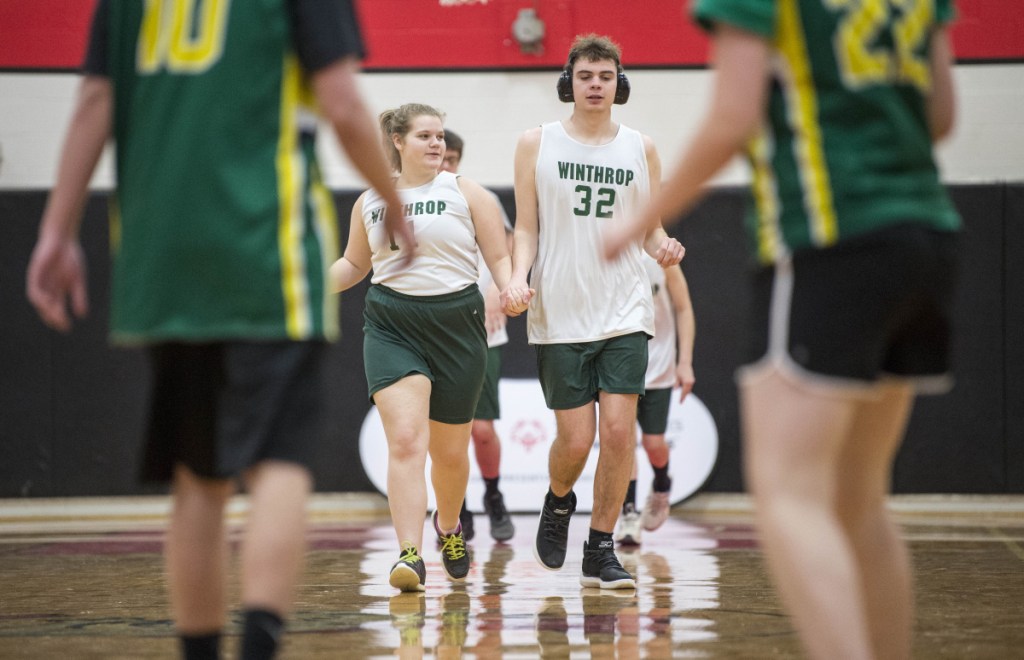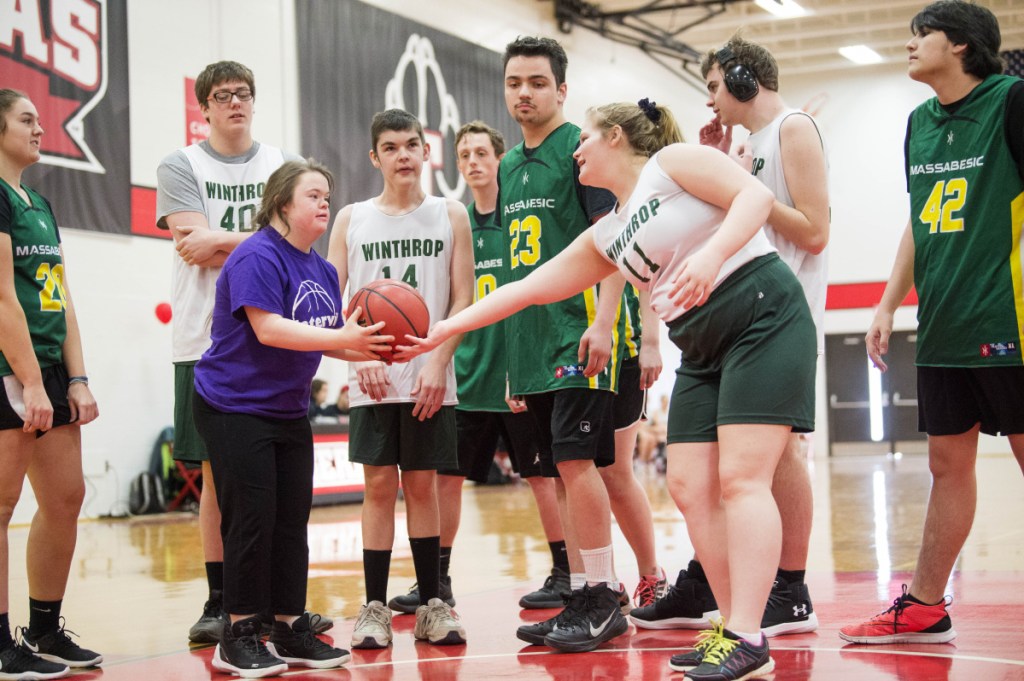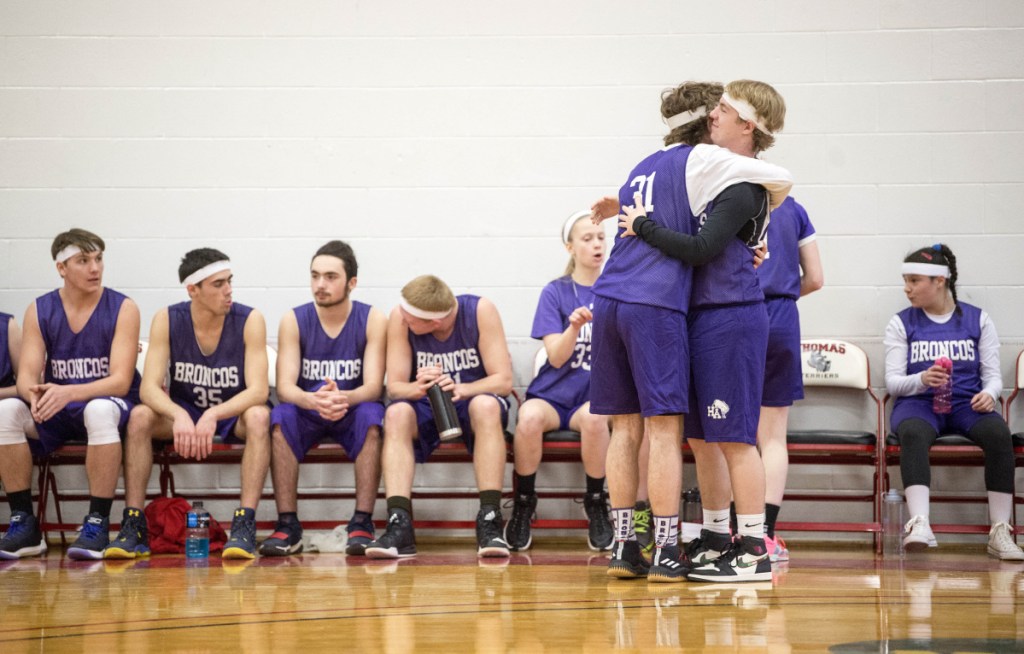
Winthrop High School’s Samantha Neumann (11) hands the ball off to an opponent from Waterville for another scoring attempt at the Unified basketball tournament Saturday at Thomas College in Waterville.
WATERVILLE — Zack Meko was an eighth-grader when he watched the Massabesic Unified basketball team play its games last season.
From that moment, he couldn’t wait for his freshman year — and his own chance to take the court — to arrive.
“I signed up because I watched their game, and they were pretty good,” he said. “Basketball’s my favorite sport. It’s great. I love it here.”
Meko is an example of a growing trend. Unified basketball, which gives athletes with intellectual disabilities a chance to play, made a splash in its first season, took off in its second and now, in its fifth season as a high school sport in Maine, has seen that growth only continue as word of mouth and the sight of a successful sport in action have allowed its roots to spread to more and more communities.
“It has grown tremendously,” Hampden/Bangor coach Andrea Lee said. “I think there are about 60 schools involved. … There are more schools that are jumping on board.”
The numbers back that up. There are now 55 teams representing 62 schools in a two-region sport that started out with 17 teams in one region five years ago. Four teams — Belfast, Lawrence, Medomak Valley and Mountain Valley — are new for this season. And Unified’s growth even goes beyond basketball; Unified track and field will be offered in the spring for the second year, and Unified volleyball made its debut this season.
“I think people are jumping on board with the movement of including all. Because this is really giving a chance for those students who may not have an opportunity to play at an elite level,” Lee said. “It’s a game-changer. That’s the bottom line, it’s a game-changer for our schools.”
Events like Saturday’s Unified Basketball Winter Jamboree help the sport get the sort of exposure needed to sustain that growth. Seven teams made it to Thomas College for the tournament, which featured 13 games between 9 a.m. and 4 p.m. and allowed the athletes to play in front of encouraging, supportive crowds.
“You can just come and have fun without being judged,” Hampden senior Dana Faloon said. “(I like) the teamwork and the motivation of helping other people with disabilities. Because they don’t really have a big chance in the world like other guys.”
More and more, people are getting that message. Lee, whose team made the final last season before losing to Westbrook, said she almost needed to form two teams due to an abundance of both athletes and partners — students without disabilities who help the athletes during the games — and Massabesic coach Katherine Fournier said she had to turn kids away because the roster swelled too much.

Hampden Academy’s Josh Stebbins (31) embraces teammate Ethan Quimby (30) as he takes the bench after playing against Leavitt at the Unified basketball tournament Saturday at Thomas College in Waterville.
“That’s a good problem to have,” she said. “We started out with just about 12 kids and our team’s doubled in size over the last four years. So it’s really great. Both (with) partners and athletes that are interested in playing, the numbers keep going up.”
There weren’t any rules changes made for this season, but that doesn’t mean coaches see the same product on the court that they saw in 2015. Fournier said that the quality of play has improved as athletes and partners have become more comfortable on the court together.
“I’ve noticed the level of play go up,” she said. “I’ve noticed the athletes and partners are getting more competitive and really playing more cohesively as a team. … I think it’s harder to tell who’s who, and I like that. That’s the direction we should be heading.”
John Vartanian, who coaches a Carrabec team that used to form a co-op with Madison but had enough athletes to play on its own this year, echoed that observation.
“When you see the kids out here playing they take it 110 percent serious, just like if any other person was playing,” he said. “At first they’d take it pretty easy. … Now you watch them play, and you just think it’s a regular high school team playing a varsity game. The intensity’s definitely gotten ramped up.”
Vartanian attributes that to players like Massabesic’s Meko, who see the sport in action and decide to pursue it when they get to high school.
“(It’s) because of everything growing,” he said. “Younger kids that are in the special ed or special needs program are looking forward to playing Unified basketball and getting involved, and getting really excited about it.”
While the sport has grown as a whole, there have been individual exceptions. Winthrop co-coach Lauren McHatten said her senior-heavy team went from 20 to 10 players, and Massabesic’s Fournier said even her robust roster could face those challenges soon.
“Numbers-wise, there seem to be waves,” she said. “When we first started we didn’t have many, and now I have a bunch of kids. So that’s good. But when those kids graduate we’ll be in a hole again. I bet we’re going to be on the smaller side.”
Still, it’s hard to find much pessimism regarding a sport that only seems to be climbing.
“I think, as the word gets out, more parents are encourgaing their kids to particpate in it,” Fournier said. “Word’s getting out, (and) it’s becoming a bigger thing.”
Drew Bonifant — 621-5638
dbonifant@centralmaine.com
Twitter: @dbonifantMTM
Copy the Story LinkSend questions/comments to the editors.





Success. Please wait for the page to reload. If the page does not reload within 5 seconds, please refresh the page.
Enter your email and password to access comments.
Hi, to comment on stories you must . This profile is in addition to your subscription and website login.
Already have a commenting profile? .
Invalid username/password.
Please check your email to confirm and complete your registration.
Only subscribers are eligible to post comments. Please subscribe or login first for digital access. Here’s why.
Use the form below to reset your password. When you've submitted your account email, we will send an email with a reset code.